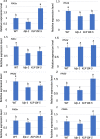Loose Plant Architecture 1-Interacting Kinesin-like Protein KLP Promotes Rice Resistance to Sheath Blight Disease
- PMID: 34215911
- PMCID: PMC8253871
- DOI: 10.1186/s12284-021-00505-9
Loose Plant Architecture 1-Interacting Kinesin-like Protein KLP Promotes Rice Resistance to Sheath Blight Disease
Abstract
Background: Sheath blight disease (ShB) is a destructive disease affecting rice production. Previously, we have reported that Loose Plant Architecture 1 (LPA1) promotes resistance to ShB. However, the mechanisms by which LPA1 confers resistance against this disease have not been extensively investigated. Notably, interactors that regulate LPA-1 activity remain elusive.
Findings: In this study, we identified the interaction of kinesin-like protein (KLP) with LPA1 in the nucleus of rice cells by yeast two-hybrid, bimolecular fluorescent complimentary (BiFC), and co-immunoprecipitation (co-IP) assays. To investigate the role of KLP in promoting resistance to ShB, wild-type, klp mutant, and KLP overexpressor (KLP OX) rice plants were inoculated with Rhizoctonia solani AG1-IA. The results indicated that, compared with the wild-type control, klp mutants were more susceptible while KLP OX plants were less susceptible to ShB. Since LPA1 transcriptionally activates PIN-FORMED 1a (PIN1a), we examined the expression of 8 related PIN genes. The results showed that only the expression of PIN1a and PIN3b coincided with KLP expression levels. In addition, a chromatin immunoprecipitation (ChIP) assay showed that KLP bound directly to the promoter region of PIN1a but not of PIN3b. Transient expression assays confirmed that LPA1 and KLP transcriptionally activate PIN1a, and that coexpression of KLP and LPA1 had an additive effect on the activation of PIN1a, suggesting that KLP enhances LPA1 transcriptional activation activity.
Conclusions: Taken together, our results show that KLP is a novel LPA1 interactor that promotes resistance of rice to ShB.
Keywords: Defense; KLP; Rice; Sheath blight disease; Transcription activation.
Conflict of interest statement
The authors declare no conflict of interest.
Figures




Similar articles
-
Indeterminate Domain Proteins Regulate Rice Defense to Sheath Blight Disease.Rice (N Y). 2020 Mar 6;13(1):15. doi: 10.1186/s12284-020-0371-1. Rice (N Y). 2020. PMID: 32140886 Free PMC article.
-
SLR1-LPA1 signal regulates sheath blight resistance and lamina joint angle in rice.Plant Physiol Biochem. 2025 May;222:109689. doi: 10.1016/j.plaphy.2025.109689. Epub 2025 Feb 25. Plant Physiol Biochem. 2025. PMID: 40015197
-
Overexpression of Calcineurin B-like Interacting Protein Kinase 31 Promotes Lodging and Sheath Blight Resistance in Rice.Plants (Basel). 2024 May 9;13(10):1306. doi: 10.3390/plants13101306. Plants (Basel). 2024. PMID: 38794377 Free PMC article.
-
Indeterminate domain 3 negatively regulates plant erectness and the resistance of rice to sheath blight by controlling PIN-FORMED gene expressions.Plant Signal Behav. 2020 Nov 1;15(11):1809847. doi: 10.1080/15592324.2020.1809847. Epub 2020 Aug 25. Plant Signal Behav. 2020. PMID: 32842845 Free PMC article.
-
Progress in rice sheath blight resistance research.Front Plant Sci. 2023 Mar 24;14:1141697. doi: 10.3389/fpls.2023.1141697. eCollection 2023. Front Plant Sci. 2023. PMID: 37035075 Free PMC article. Review.
Cited by
-
NtLPA1 overexpression regulates the growth of tobacco and enhances resistance to blight.Transgenic Res. 2025 Jan 9;34(1):8. doi: 10.1007/s11248-024-00420-x. Transgenic Res. 2025. PMID: 39786624
-
Rhizoctonia solani Kühn Pathophysiology: Status and Prospects of Sheath Blight Disease Management in Rice.Front Plant Sci. 2022 May 3;13:881116. doi: 10.3389/fpls.2022.881116. eCollection 2022. Front Plant Sci. 2022. PMID: 35592572 Free PMC article.
-
INDETERMINATE DOMAIN Transcription Factors in Crops: Plant Architecture, Disease Resistance, Stress Response, Flowering, and More.Int J Mol Sci. 2024 Sep 24;25(19):10277. doi: 10.3390/ijms251910277. Int J Mol Sci. 2024. PMID: 39408609 Free PMC article. Review.
-
Malectin Domain Protein Kinase (MDPK) Promotes Rice Resistance to Sheath Blight via IDD12, IDD13, and IDD14.Int J Mol Sci. 2022 Jul 26;23(15):8214. doi: 10.3390/ijms23158214. Int J Mol Sci. 2022. PMID: 35897795 Free PMC article.
-
Biotechnological breakthroughs in rice disease management: an overview from transgenics to CRISPR.Mol Biol Rep. 2025 Jun 20;52(1):616. doi: 10.1007/s11033-025-10701-1. Mol Biol Rep. 2025. PMID: 40540136 Review.
References
-
- Kouzai Y, Kimura M, Watanabe M, Kusunoki K, Osaka D, Suzuki T, Matsui H, Yamamoto M, Ichinose Y, Toyoda K, Matsuura T, Mori IC, Hirayama T, Minami E, Nishizawa Y, Inoue K, Onda Y, Mochida K, Noutoshi Y. Salicylic acid-dependent immunity contributes to resistance against Rhizoctonia solani, a necrotrophic fungal agent of sheath blight, in rice and Brachypodium distachyon. New Phytol. 2018;217(2):771–783. doi: 10.1111/nph.14849. - DOI - PMC - PubMed
-
- Li J, Jiang J, Qian Q, Xu Y, Zhang C, Xiao J, Du C, Luo W, Zou G, Chen M, Huang Y, Feng Y, Cheng Z, Yuan M, Chong K. Mutation of rice BC12/GDD1, which encodes a kinesin-like protein that binds to a GA biosynthesis gene promoter, leads to dwarfism with impaired cell elongation. Plant Cell. 2011;23(2):628–640. doi: 10.1105/tpc.110.081901. - DOI - PMC - PubMed
Grants and funding
LinkOut - more resources
Full Text Sources
Miscellaneous

